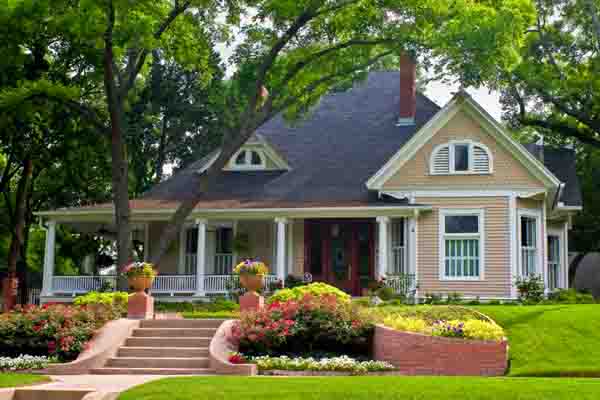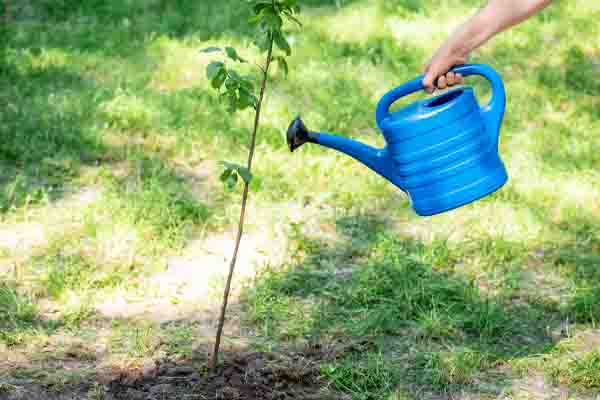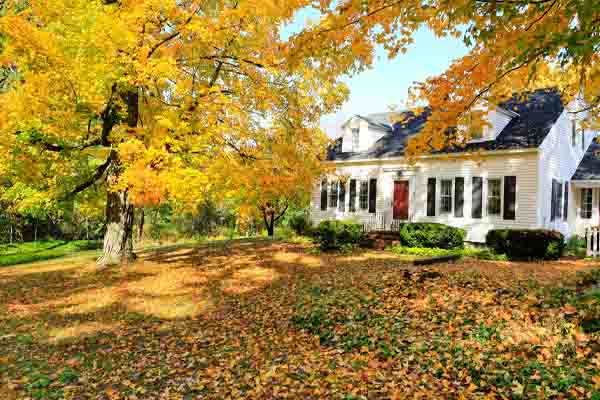
When it comes to managing energy costs, many homeowners and businesses often overlook the potential benefits of trees. With their lush foliage and towering canopies, these majestic plants offer more than just aesthetic beauty. Homeowners can significantly reduce their heating and cooling costs by strategically planting trees around their property. These trees act as natural air conditioners, providing shade that shields buildings from direct sunlight. It decreases the need for excessive cooling. Trees also act as windbreakers which help reduce heat loss during colder seasons. You can enjoy a greener and more pleasant environment while using the energy saving potentials of shade trees.
Energy Saving Potentials Of Shade Trees
Table of Contents
In this article, we will discuss how trees can help reduce your energy consumption and improve the overall aesthetic and value of your property.
Related Article: What is a High-Velocity Mini Duct Air Conditioning System?
What Is Smart Landscaping?

Smart landscaping goes beyond mere aesthetics and can play a crucial role in improving energy efficiency. Intelligent landscape design principles help create a sustainable outdoor environment that maximizes energy conservation. Here’s how smart landscaping can contribute to energy efficiency and lower HVAC expenses:
- Shade and Sunlight Control: Strategic placement of trees can provide shade, reducing the amount of direct sunlight reaching the building’s window and exterior walls. The natural shade acts as a barrier that prevents heat from entering your home and minimizes the need for air conditioning. HVAC systems can operate more efficiently when their workload is reduced, which ultimately results in significant energy savings.
- Windbreaks and Insulation: Well-placed trees act as windbreaks that deflect chilly winds during winter. This is a natural insulation that helps reduce heat loss, allowing the HVAC system to maintain a comfortable indoor temperature more efficiently. Energy consumption and costs are reduced when you decrease the demand for heating.
- Evapotranspiration and Cooling Effect: Trees and green spaces can contribute to cooling through a process called evapotranspiration. Trees release moisture into the air, creating a natural cooling effect that can help offset the need for excessive air conditioning. Property owners can mitigate the urban heat island effect and reduce reliance on HVAC systems by incorporating green areas in the landscape design.
- Proper Airflow and Ventilation: Thoughtful placement of trees can enhance airflow and ventilation around the building. Directing breezes towards windows and outdoor living spaces promotes natural ventilation and fresh air circulation. This can reduce the dependency on ventilation systems, which lowers energy consumption and associated HVAC costs.
Where to Plant Trees To Reduce Your HVAC Costs
It would help if you considered the size and growth characteristics of the tree species you chose to determine the best area to place them. Consult a professional landscaper and your trusted HVAC company to help select suitable tree species and proper placement for maximum energy efficiency. Here are some key areas to consider for tree placement:
- West and Southwest Side: Planting trees on the western and southwestern sides of your property can provide adequate shade during the hottest time of the day. Trees can block intense afternoon sun, preventing it from directly entering windows and heating up the home or building. This reduces the load on your HVAC system, resulting in energy savings.
- South Side: Trees on the southern side of your property can provide shade throughout the day, especially during the summer. By casting their shadows over the building, trees help keep it cooler. On the other hand, these trees shed their leaves during winter, allowing sunlight to reach the building and provide natural warmth.
- East Side: Planting trees on the east side of your property can provide morning shade, which is beneficial during the hot summer months. They block the early morning sunlight, preventing excessive heat gain and reducing the need for cooling. This can be especially useful for east-facing windows and areas where the morning sun can cause discomfort.
- Rooftop: Consider planting trees near or on your building’s rooftop, particularly if it is flat or has a low slope. Trees can create a microclimate that helps insulate the building and reduce heat absorption. The shade provided by rooftop trees can significantly decrease the temperature on the roof, reducing the workload on the HVAC systems.
- Outdoor Units: Be careful when planting trees near outdoor HVAC units, so they do not obstruct airflow or hinder maintenance access. Maintain a safe distance to prevent leaves, branches, or debris from clogging the unit or interfering with its functionality. Strategic placement of trees can still provide shade while allowing proper ventilation and accessibility.
Related Article: Why Your Outside AC Unit Keeps Tripping The Breaker
Choosing the Tree Type
Choosing the type of tree that will suit your climate zone, location, and landscape is crucial. Consider the following characteristics:
Related Article: 10 Reasons Why Your AC Unit Isn’t Blowing Cool Air
Size and Canopy
Opt for trees with a mature height and canopy size that suits your specific needs. Trees with broad, spreading canopies offer more shade and coverage, effectively blocking sunlight. Make sure that the size of the tree is appropriate to your property to avoid overcrowding or shading neighboring structures.
Native Species
Consider planting trees that are native to your region. Native species are typically well-adapted to the local climate, soil conditions, and pests, requiring less maintenance and resources. They are more likely to thrive, providing long-term energy-saving benefits.
Related Article: Tell-Tale Signs of An Overcharged Air Conditioner
Deciduous Trees

Choose deciduous trees for areas where you want to maximize the benefits of both shade and sunlight. These trees provide shade during the summer months when their foliage is full, reducing the need for cooling. In the winter, they shed their leaves, allowing sunlight to reach the building and providing natural heat.
Related Article: What Are 3 Ways That You Can Tell If Your Heater Is Energy Efficient?
Fast-Growing Varieties
For quicker results, choose fast-growing tree species. These trees establish themselves rapidly, providing shade and energy savings sooner. However, be mindful of their potential size at maturity and make sure they won’t overshadow or cause issues with nearby structures or utility lines.
Low-Maintenance Trees
Consider trees that require minimal upkeep and have good disease resistance. Low-maintenance trees can save time, effort, and money on pruning, fertilization, and pest management. The aim is to save money from energy costs and not gain additional expenses for various maintenance and upkeep of trees.
Some examples of tree species that often exhibit favorable characteristics for energy efficiency include:
- Oak
- Maple
- Willow
- Poplar
- Elm
- Beech
- Ash
Save More Energy With an HVAC Tune-Up
While you are decreasing energy costs through the wise use of shade trees, you will also be adding value to your home. Another great idea for creating a more energy-efficient home is scheduling annual air conditioning or heating tune-up. This helps reduce energy costs that can skyrocket during hot and cold weather. It also makes your system last longer, which prevents a costly premature replacement. Be sure to find a reputable HVAC company, like Skylands Energy Service, to handle all of your heating and cooling services. Be sure to give us a call today.
Related Article: Which Is More Efficient A Fireplace Or Furnace?
Conclusion
Using trees and smart landscaping techniques to mitigate HVAC costs is a wise and sustainable approach. Consult your trusted HVAC company for expert guidance. They can assess your specific needs, provide recommendations on tree selection and placement, and compatibility with your HVAC system. By working together with your HVAC experts and leveraging the benefits of trees, you can make informed decisions and achieve optimal energy efficiency. This can lead to long-term energy savings and a greener environment.
Related Article: Best Ways to Maintain Your Hydronic Heating System
Call Skylands Energy Service For All Of Your HVAC Requirements

Skylands Energy Service is the premier provider of heating and cooling solutions throughout Central New Jersey. Our team comprises highly skilled and certified technicians specializing in HVAC tune-ups, repairs, installations, and replacements. We take immense pride in delivering top-quality services to all our valued clients.
At Skylands Energy Service, we fully comprehend the significance of a comfortable and energy-efficient home. That’s why we offer competitive pricing for our services. Our maintenance programs are designed to enhance your comfort while reducing energy costs. Whether you require HVAC repairs or replacements, our knowledgeable technicians will recommend the best options tailored to your budget. We stand firmly behind our work and offer a satisfaction guarantee.
To schedule a service appointment with us, simply give us a call. We provide free, in-home estimates to ensure informed decision-making about your HVAC systems. Rest assured, Skylands Energy Service is committed to delivering exceptional heating and cooling services surpassing your expectations!
Contact us now at (908) 707-1776 to find out more! Click the link to view our service area.

